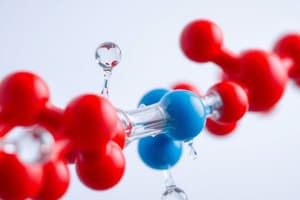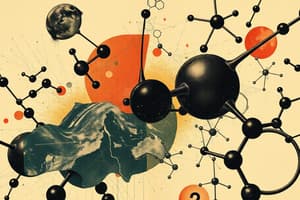Podcast
Questions and Answers
Which property of water allows it to absorb a lot of energy before increasing in temperature?
Which property of water allows it to absorb a lot of energy before increasing in temperature?
- Expands upon freezing
- Density
- Moderates temperature (correct)
- Cohesion
Ice is denser than liquid water.
Ice is denser than liquid water.
False (B)
What term describes substances that dissolve easily in water?
What term describes substances that dissolve easily in water?
hydrophilic
The pH of blood must be kept between ______ and ______.
The pH of blood must be kept between ______ and ______.
Match the following properties of water to their descriptions:
Match the following properties of water to their descriptions:
What type of molecule is defined as a hydrocarbon?
What type of molecule is defined as a hydrocarbon?
Functional groups in organic molecules have no impact on the chemical properties of those molecules.
Functional groups in organic molecules have no impact on the chemical properties of those molecules.
What is the significance of hydrogen bonds in water molecules?
What is the significance of hydrogen bonds in water molecules?
What happens when proteins lose their structure?
What happens when proteins lose their structure?
Enzymes decrease the rate of chemical reactions in the body.
Enzymes decrease the rate of chemical reactions in the body.
What is the inactive form of enzymes called?
What is the inactive form of enzymes called?
DNA is ________ to RNA before proteins are created.
DNA is ________ to RNA before proteins are created.
Match each type of RNA with its primary function:
Match each type of RNA with its primary function:
What is the main role of ATP in the cell?
What is the main role of ATP in the cell?
RNA and DNA contain the same nitrogenous bases.
RNA and DNA contain the same nitrogenous bases.
The reaction products are released, freeing the enzyme to act on more ________.
The reaction products are released, freeing the enzyme to act on more ________.
What type of molecule assists enzyme catalysis and is usually organic?
What type of molecule assists enzyme catalysis and is usually organic?
Which of the following is NOT a class of biological molecules?
Which of the following is NOT a class of biological molecules?
Which of the following classes of biological monomers includes glucose?
Which of the following classes of biological monomers includes glucose?
All lipids are hydrophilic molecules.
All lipids are hydrophilic molecules.
What type of linkage is formed when monosaccharides are joined together?
What type of linkage is formed when monosaccharides are joined together?
The monomers of proteins are called ________.
The monomers of proteins are called ________.
Match the following types of fatty acids with their descriptions:
Match the following types of fatty acids with their descriptions:
Which compound represents a storage polysaccharide in animals?
Which compound represents a storage polysaccharide in animals?
Humans possess the enzyme to break down cellulose.
Humans possess the enzyme to break down cellulose.
What are eicosanoids and why are they important?
What are eicosanoids and why are they important?
Triglycerides are composed of three fatty acids bonded to a ________ backbone.
Triglycerides are composed of three fatty acids bonded to a ________ backbone.
Which type of structure is described as the arrangement of polypeptide chains in a protein?
Which type of structure is described as the arrangement of polypeptide chains in a protein?
All proteins exhibit a quaternary structure.
All proteins exhibit a quaternary structure.
What is the main difference between saturated and unsaturated fatty acids?
What is the main difference between saturated and unsaturated fatty acids?
Steroids have a structure made from ________ fused carbon rings.
Steroids have a structure made from ________ fused carbon rings.
Match the following types of proteins with their characteristics:
Match the following types of proteins with their characteristics:
Flashcards are hidden until you start studying
Study Notes
Water Properties
- Exhibits cohesion: water molecules stick together.
- Moderates temperature: absorbs significant heat before temperature increases; releases heat to environment, regulating temperature (e.g., sweat).
- Expands upon freezing: ice floats on water due to hydrogen bond-induced lattice structure, allowing aquatic life to survive winter.
- Is a solvent: polar nature allows dissolving polar and charged substances (hydrophilic); nonpolar substances (hydrophobic) like lipids do not dissolve.
- Buffers minimize pH changes: crucial for maintaining blood pH (7.35-7.45), blood is over 90% water.
- Hydrogen bonds crucial for water's properties and life.
Matter and Organic Molecules
- All matter, including living things, follows chemical and physical laws.
- Organic molecules contain carbon.
- Hydrocarbons contain only carbon and hydrogen.
- Functional groups attached to carbon skeletons determine chemical properties and molecular function (e.g., steroid hormones).
Biological Macromolecules
- Biological molecules are complex organic compounds, mainly polymers of monomers.
- Four classes of biological monomers: carbohydrates, lipids, proteins, and nucleic acids.
Carbohydrates
- Compounds containing carbon, hydrogen, and oxygen.
- Monosaccharides (simple sugars) are carbohydrate monomers.
- Joined by dehydration synthesis forming glycosidic linkages.
- Disaccharides: two monosaccharides; polysaccharides: many monosaccharides.
- Glycogen (animal storage) and starches (plant storage) are glucose polymers, differing in glycosidic bond stereochemistry.
- Humans lack the enzyme to break down cellulose.
Lipids
- Hydrophobic molecules (carbon, hydrogen, little oxygen).
- Types: fatty acids, triglycerides, phospholipids, steroids, eicosanoids, fat-soluble vitamins.
- Fatty acids: hydrocarbon chain with carboxyl group; saturated (single C-C bonds) or unsaturated (one or more C-C double bonds).
- Triglycerides: three fatty acids bonded to glycerol; fats (solid) and oils (liquid). Stored in adipocytes (fat cells).
- Phospholipids: glycerol, two fatty acids, phosphate group; amphipathic (hydrophilic head, hydrophobic tails).
- Steroids: four fused carbon rings; cholesterol is precursor; sterols have hydroxyl group, slightly amphipathic.
- Eicosanoids: 20-carbon compounds (e.g., prostaglandins, leukotrienes).
- Lipids lack a single monomer.
Proteins
- Large molecules (carbon, hydrogen, oxygen, nitrogen).
- Monomers are amino acids (20 types).
- Amino acids have amino group, carboxyl group, and R group (determines properties).
- Peptide bonds link amino acids via dehydration synthesis.
- Polypeptides: many amino acids.
- Protein structure determines function.
- Primary: amino acid sequence (gene determines)
- Secondary: repeated folds (α-helices, β-sheets); stabilized by hydrogen bonds.
- Tertiary: 3D shape; determined by primary and secondary structure, bonds (disulfide bridges, hydrogen bonds, ionic bonds), and hydrophobic interactions.
- Quaternary: arrangement of multiple polypeptide chains (not all proteins have this).
- Fibrous proteins: long, parallel bundles; water-insoluble (e.g., keratin, actin).
- Globular proteins: round; water-soluble (e.g., antibodies, most enzymes).
- Denaturation: loss of protein structure and function.
Enzymes
- Biological catalysts; accelerate reaction rates without being consumed.
- May require cofactors (organic cofactors are coenzymes).
- Highly specific: substrates bind to active sites ("lock and key" mechanism).
- Efficient: lower activation energy (energy needed to start a reaction).
- Regulated: cells control enzyme synthesis and activity; proenzymes are inactive precursors.
Nucleic Acids
- Made of carbon, hydrogen, oxygen, nitrogen, and phosphorus.
- DNA (deoxyribonucleic acid), RNA (ribonucleic acid).
- Genes (DNA segments) code for proteins.
- DNA is transcribed to RNA, RNA is translated to proteins.
- Monomers are nucleotides (nitrogenous base, pentose sugar, phosphate group).
- DNA bases: A, G, C, T; RNA bases: A, G, C, U.
- A and G are purines; T and C are pyrimidines; purines pair with pyrimidines.
- DNA pentose sugar: deoxyribose; RNA pentose sugar: ribose.
- DNA double helix: bases form "rungs," phosphate-sugar backbone.
- DNA replication: makes a copy of DNA; mutations are changes in nucleotide sequence.
- RNA is single-stranded: mRNA, rRNA, tRNA.
Adenosine Triphosphate (ATP)
- Biologically important nucleotide; energy currency of cells.
- Adenine, ribose, three phosphate groups.
- ATP hydrolysis (phosphate loss) releases energy, used in endergonic (energy-requiring) reactions.
- ATP synthase catalyzes ATP synthesis during cellular respiration.
Summary of Biological Molecules
- Diverse organic molecules.
- Four classes: carbohydrates, lipids, proteins, nucleic acids.
- All are polymers of monomers except lipids.
- Structure strongly influences function.
Studying That Suits You
Use AI to generate personalized quizzes and flashcards to suit your learning preferences.




